Will a 3-season Tent Work in Pacific Northwest Winters?
The short answer is yes. I’m not going to do a detailed review of particular tents, but I want to mention a few models that I see often on our trips. I’ll also discuss a few pros and cons of using 3-season tents in the Pacific Northwest winter conditions and some of the best 4-season options available. In context, I’ll be referring to small and light tents for backpacking rather than tents that are used for basecamps and long stays in one location.
One of the great attractions of the Cascade Mountains is the incredible views. For this reason, I prefer to camp high up on exposed ridges. Being able to ride out occasional high winds allows us to enjoy the best views. Ideally, you can camp with the tent door open and enjoy the views, including the star-filled nights, and only have to zip it closed when there is a passing snowfall or high wind. It is with that kind of experience in mind that I evaluate tent designs for winter backpacking.
I don’t represent any brands and haven’t received any sponsorships. These are just my independent opinions.
3-Season Tents
What to look for in a 3-season tent for winter backpacking
- Ability to withstand moderate to high winds: This usually means an X-frame design, but not always (I’ll discuss this later).
- A steep pitch: This means narrow enough at the top to shed snow.
- A large fly: This helps to keep out drifting snow. The closer the fly extends to the ground, the better.
- Lightweight: Overall, winter gear is heavy so having ultra-light backpacking gear is helpful. For this reason, I am mainly interested in solo tents that are in the 2–4 pound range.
Most of the hikers I know pack to be self-sufficient. They use solo tents or small 2-person tents. For safety reasons, I prefer this self-sufficient approach. Obviously, couples may want larger 2-person tents and all of the tents discussed here are available in 2-person versions.
3-Season Examples
This table shows some of the examples used by winter backpackers in our group.
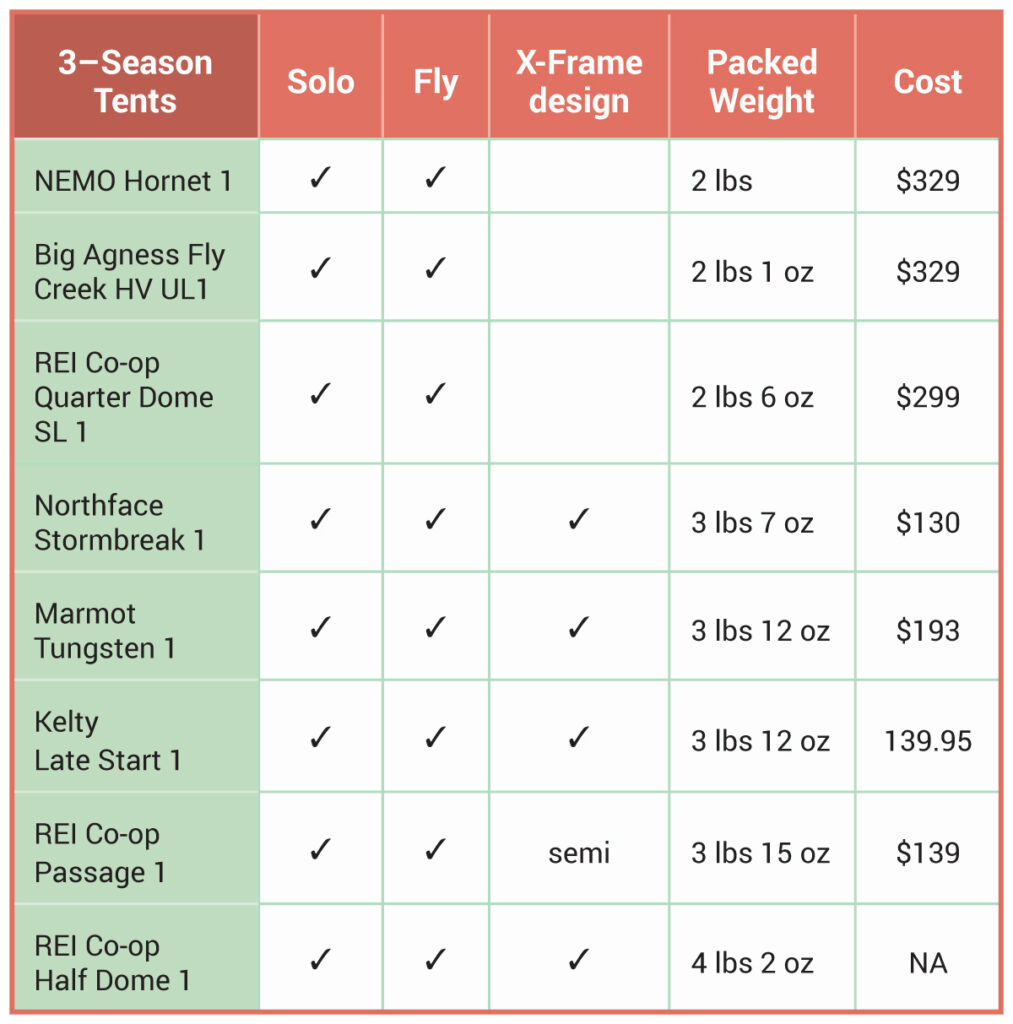
Here’s a list of these 3-season tents with links.
X-Frame designs
These tents use the X-Frame design:
- Northface Stormbreak 1 (3 lbs 7 oz, around $130.)
- Marmot Tungsten 1 (3 lbs 12 oz. $193.)
- Kelty Late Start 1 (3 lbs 12 oz. $139.95)
- REI Co-op Half Dome (4 lbs 2 oz, no longer available)
- REI Co-op Passage 1 (4 lbs 10 oz, $139.)
The Marmot Tungsten is very similar to the Northface Stormbreak. While the Tungsten isn’t as light as the Stormbreak, the larger headroom (5″) makes it slightly more comfortable. The Kelty Late Start looks very similar to the Marmot Tungsten, but it is the one option on the list that I have never seen used.
- REI Co-op Quarter Dome SL 1 (2 lbs 6 oz, $299)
The REI Co-op Quarter Dome SL 1 is in a slightly different category because it is only a semi-X-frame design. It is lighter but more expensive than the other 3-season x-frame tents.
Lightest options
- NEMO Hornet 1 (2 lbs, $329)
- Big Agness Fly Creek HV UL1 (2 lbs 1 oz, $329.)
These are 3-season tents that use a 3-point pole design. These tents are more ultra-light and more expensive.
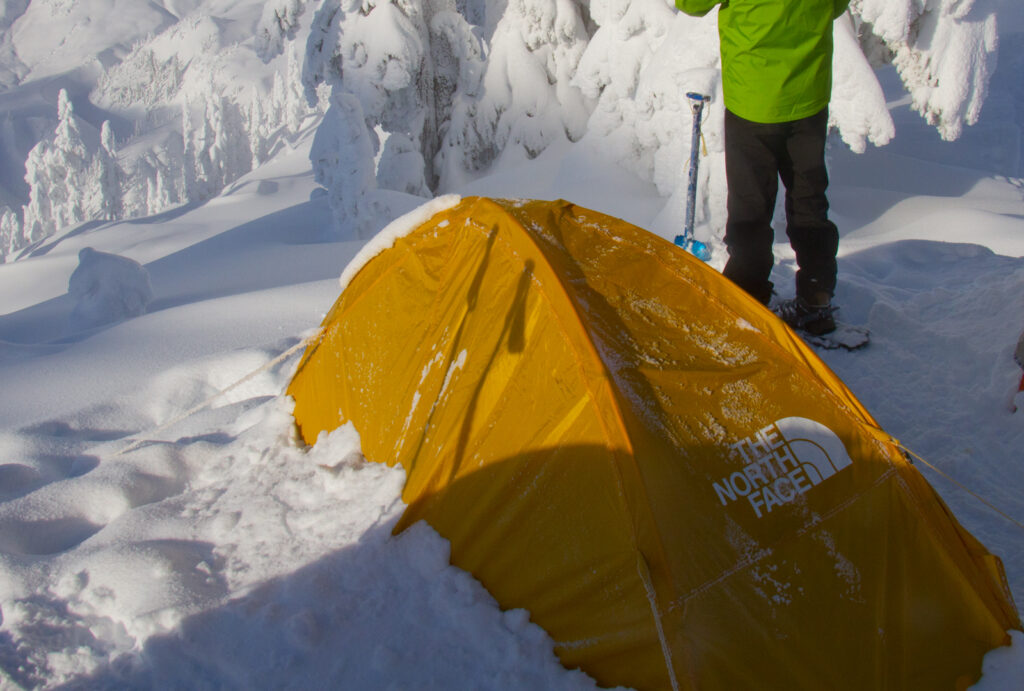
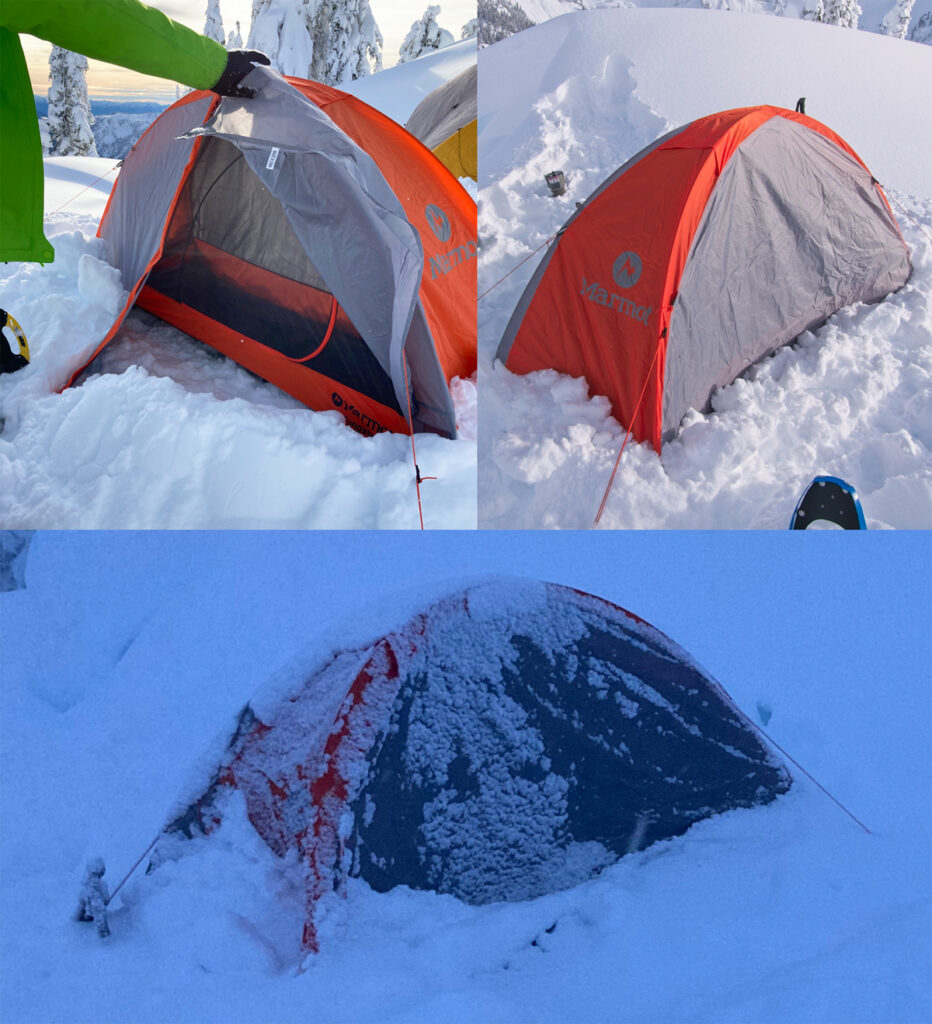
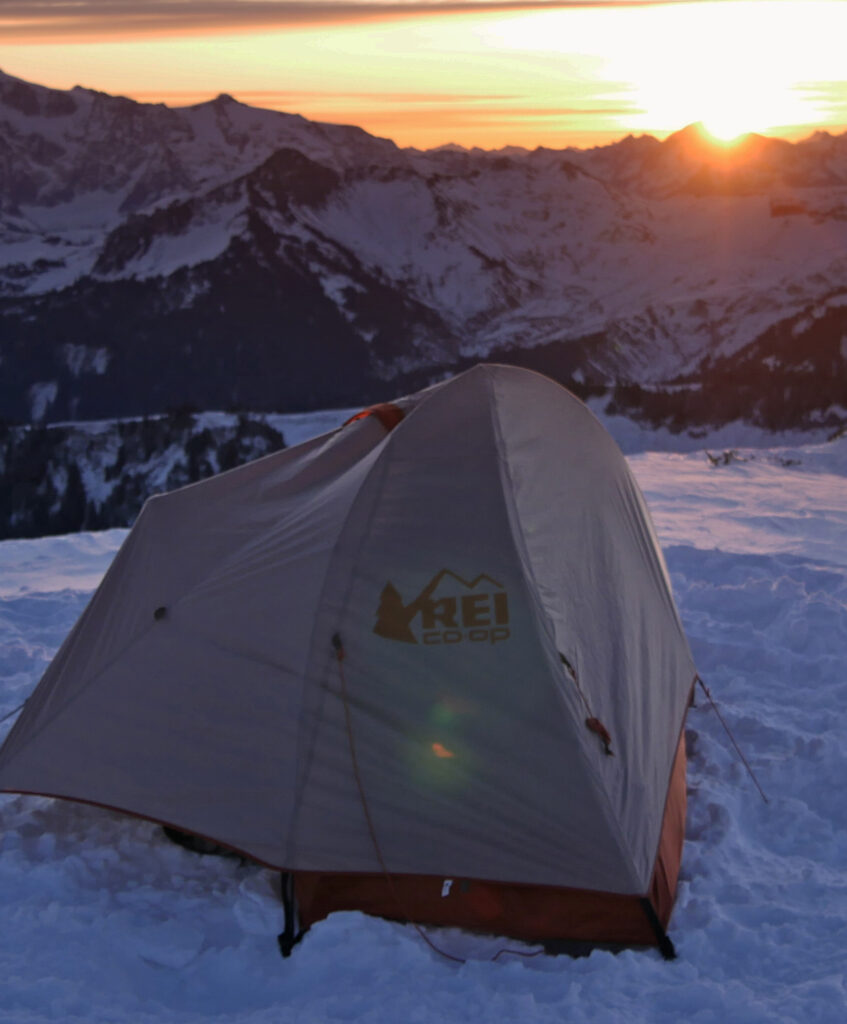
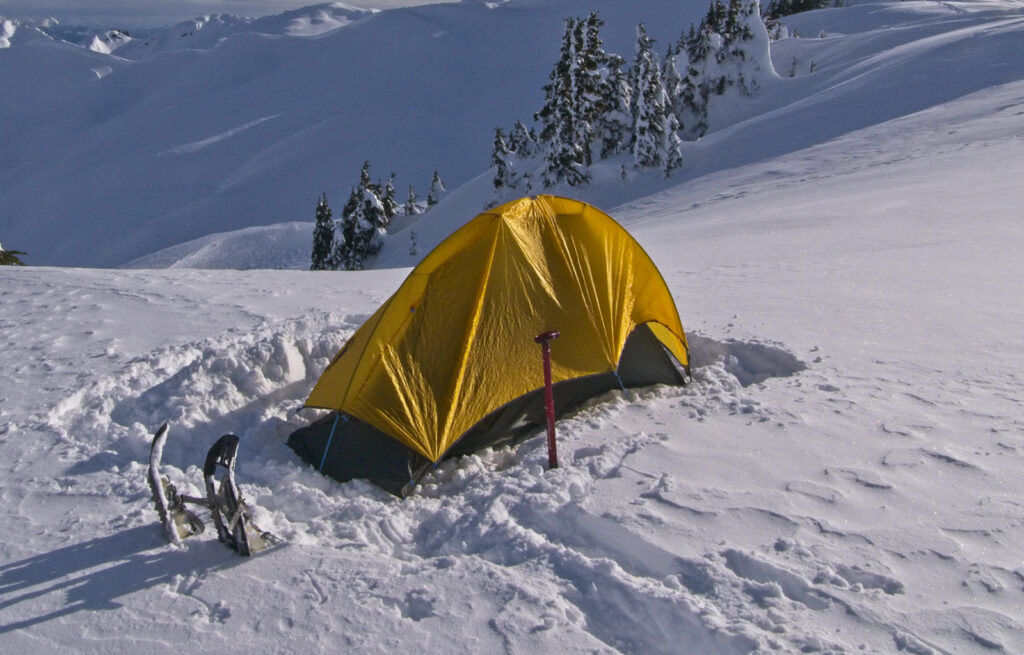
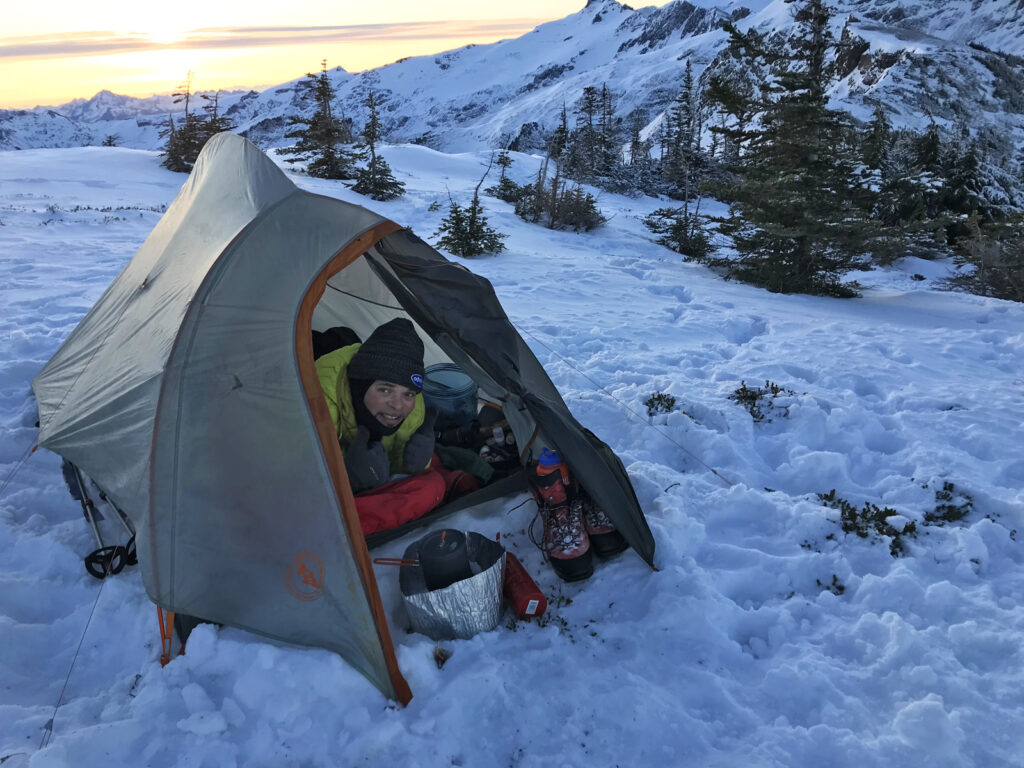
All of these tents are lightweight and packable. They shed snow and withstand mild wind well.
The Importance of Wind Protection
Be aware that most tent designs will be fine when there are low winds and no heavy snow falling. In calm weather, the experience of being in a 3-season tent is similar to being in a 4-season tent. My aim is to point out tent examples that will do better in at least mild winds and some snowfall.
The wind is the most important consideration. Wind speeds are higher and more frequent in winter. There are two main concerns:
First, will the tent keep standing or will it blow apart? Aside from gale-force winds, all of these 3-season tents featured here will likely remain standing. The second concern is whether the tent will keep out drifting snow and wind that can rob you of your warmth.
The wind passes through 3-season tents more easily than 4-season tents making the tents colder inside. Sometimes wind and drifting snow will pass under the fly and through the mosquito netting. You will feel the cold snowflakes and frozen moisture landing on your face while you are trying to sleep. To reduce this problem you can build a snow wall around the sides of the 3-season tent facing the wind, assuming there is enough snow on the ground. This helps stop snow from drifting in but is unlikely to stop it all. If the tent has a fly that reaches close to the ground it will be easier to build up snow next to it to help seal out the winds. The North Face Stormfront and Marmot Tungsten work reasonably well in this regard.
Tents can fail in high winds poles are stressed and break creating sharp exposed pole edges that cut through the tent material. One trend in tent design is to create lighter more flexible pole systems able to lay flat in high winds. The REI Co-op Quarter Dome SL 1 is such a tent. This light free-standing tent doesn’t have a ridged X-frame design, even though the poles form an X shape. Instead, the poles merge into a single hub at the top. There is also an additional top pole to add headroom. This added top pole increases the headroom but makes it more difficult for the tent to shed snow. That said, the flexible pole design allows the tent to compress in high winds rather than break. I expect snow will compress it as well.
I’m not sure what the highest wind tolerance is for the Quarter Dome tent, but the tent pictured here (the 2-person version) withstood a night of 15–25 mph gusts. It survived, but being inside a tent compressing like this is not comparable to spending the night in a 4-season tent that mostly keeps its shape.
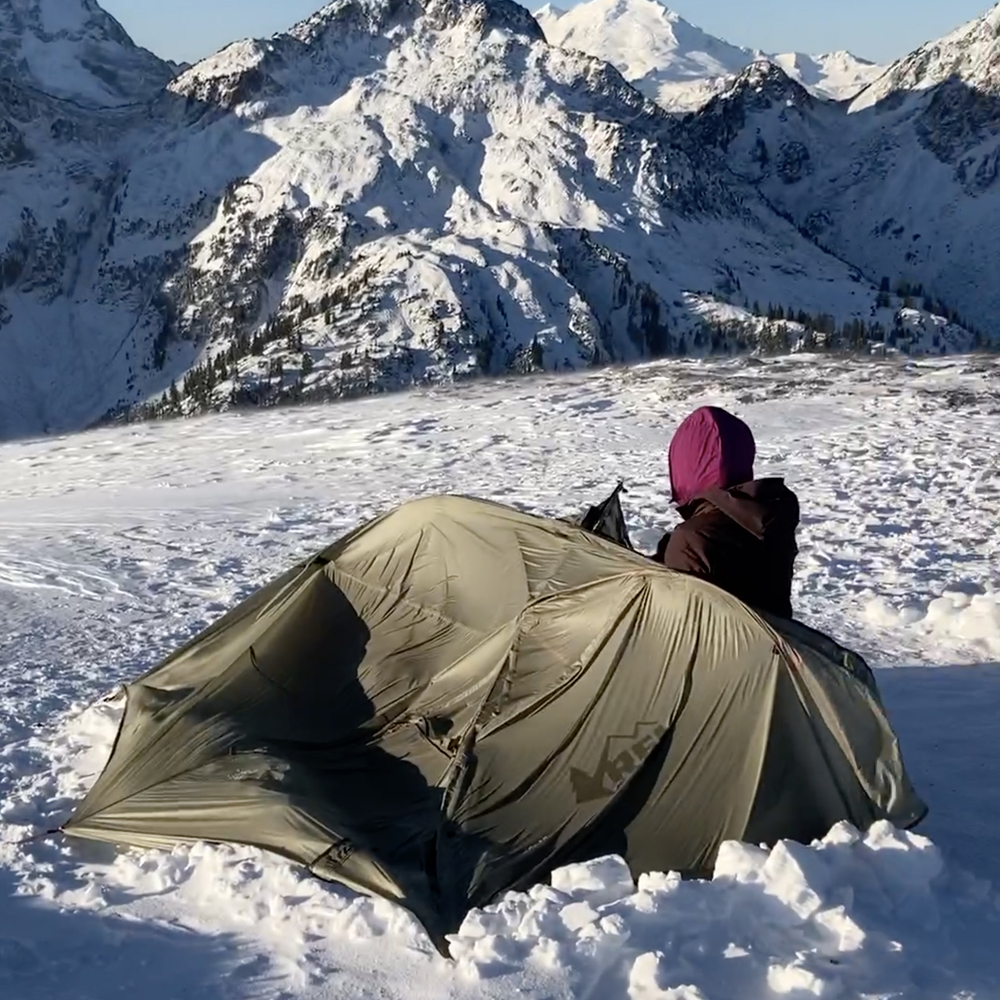
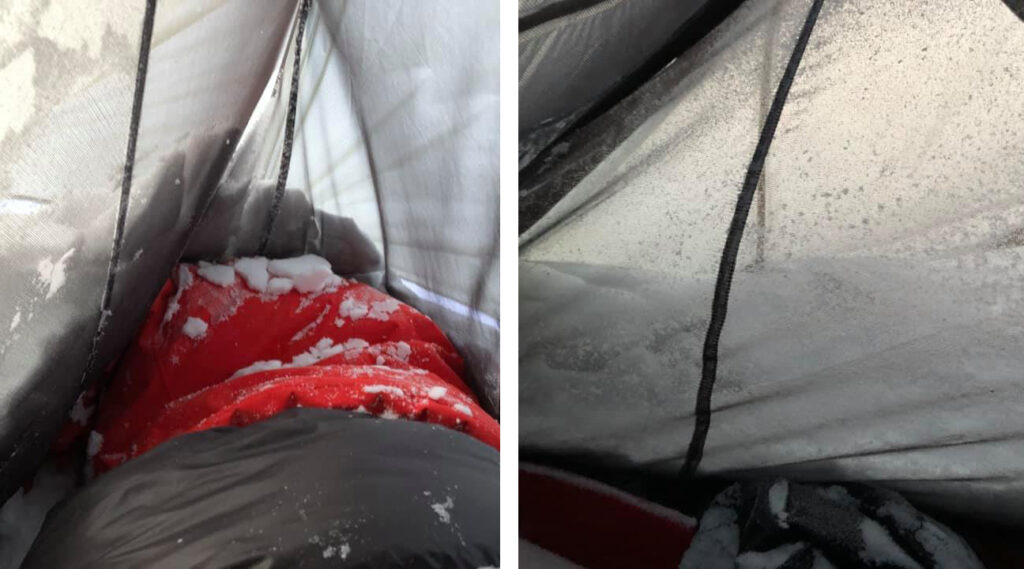
I have used a Big Agnes Copper Spur HV UL1 (1-person 3-season) tent shoulder-season snow camping, but not for trips when snowfall was anticipated. This tent has a top cross pole that makes it difficult for the tent to shed snow. The Big Agness Fly Creek HV UL1 has a steeper pitch making it a better 3-season tent choice for winter camping.
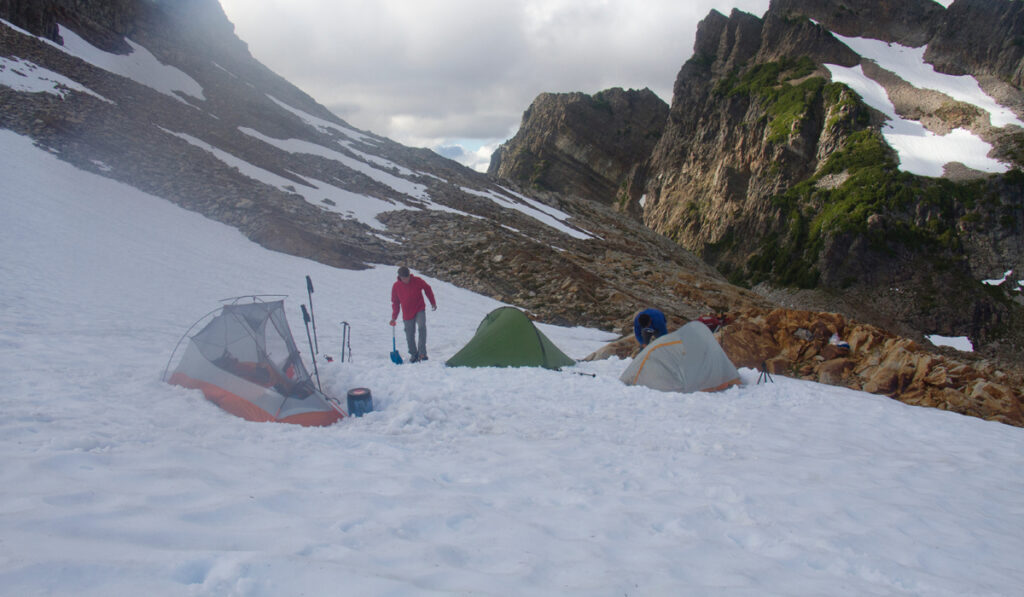
My own Copper Spur HV UL 1-person version has also withstood 20–30 mph winds, but the wind has broken the poles on two different occasions for the 2-person version of the same tent. The tent is designed to flex in high winds, but sometimes that’s not enough. The Copper Spur HV UL 2 probably failed because the tent is larger but uses the same strength poles as the UL 1.
X-Frame Design
3-season tents that use an X-frame design (the poles form an X from corner to corner) are sturdier in windy winter conditions. This is the design type used most often for small mountaineering tents that need to withstand high-elevation winds. (For more about PNW winter wind, see Preparing for Winter Wind.)
The X-frame design such as the North Face Stormbreak 1, REI Co-op Half Dome 1 Plus Tent, Kelty Solstice 1, and Kelty Late Start 1, is likely to be more wind resistant than other designs. That said, the Big Agnes Fly Creek, which doesn’t have an X-frame design has proven to be stable in high winds because the walls are so steep and one end is narrow and can be pointed at the wind.
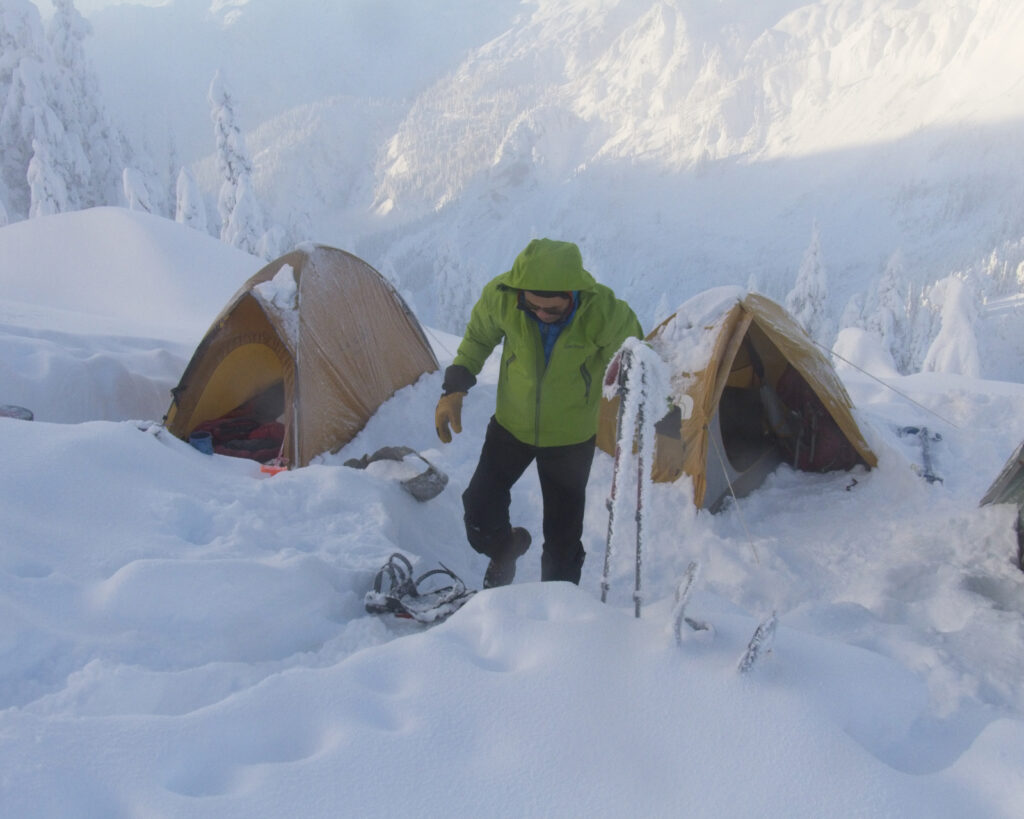
Bear in mind that it is unlikely that any of the 3-season tents mentioned here have been pitched in winds exceeding 35–40 mph on any of our trips. On one trip, winds were likely gale force (40–45mph), but not when the tents were pitched. If the wind forecast is over 20–25mph or gale force, it is better to change plans if you plan to camp on an exposed ridge.
Expedition and mountaineering tents are made for high winds because sometimes such winds cannot be avoided, especially at higher elevations. Mountaineers tend to climb in the summer or shoulder seasons when the weather is warmer and high winds less frequent. If you are winter backpacking, pay attention to the wind forecast and be prepared because you may encounter tougher conditions than many mountaineers experience.
When you are inside a tent, you are out of the weather, so you don’t need to fear the wind, just be prepared for it. (For how to prepare for winds, see “Wind and Tents: What to do if your tent fails”).
Packability
How much space a tent takes up in your pack, or packability, is also a consideration. This photo compares four tents. The North Face tent and the Big Agnes fit loosely in the stuff sacks so they will compress further, probably close to the size of the Snow Peak. A 60–65 liter pack can carry all the winter gear required for a week-long trip depending on gear choices.
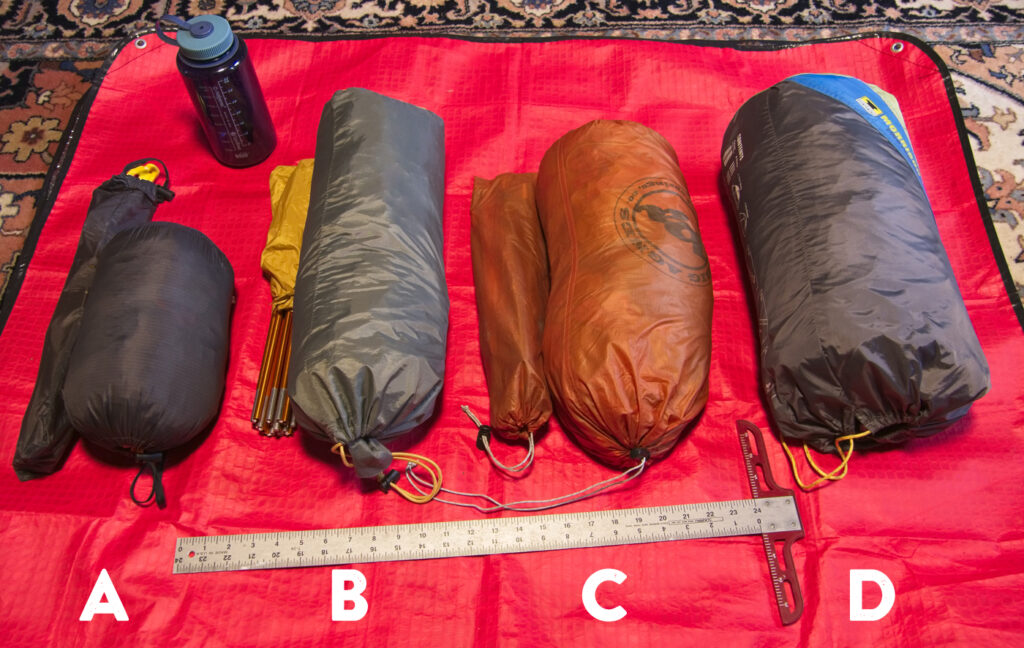
If you plan to share a tent to reduce weight, which is fine, arrive self-sufficient anyway in case that person is unable to show up or no one volunteers to share. The safest strategy is for everyone in the team to pack a kit that is complete and not reliant on others. This provides backups for important essentials such as stoves, fuel, first aid, etc. Everyone should show up fully packed and self-reliant.
What About Ultra-Light Dyneema Tents?
Ultra-light Dyneema tents seem to work well enough for the snow we encounter on most of our trips, but I have not seen them put to the test in heavy snowfall or high winds (over 20 mph). Also, once set up, you no longer have trekking poles to use when exploring around camp. Trekking poles and snowshoes are essential in deep snow conditions. Using these tents in winter isn’t ideal but you can likely get by in moderate conditions and shoulder season snow camping.
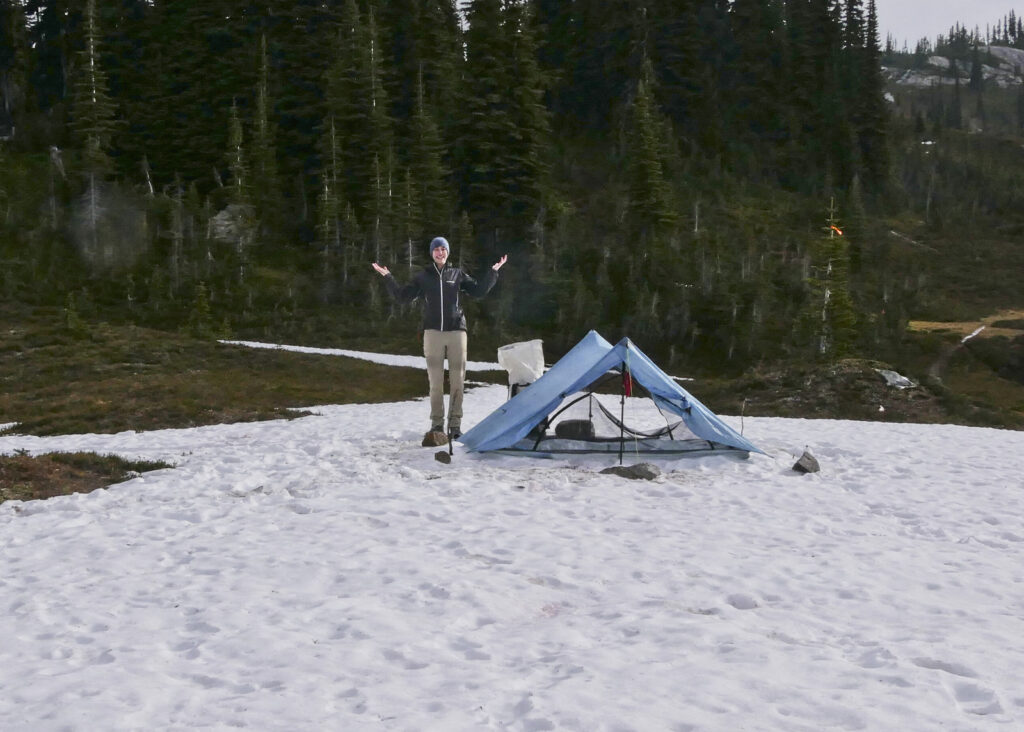
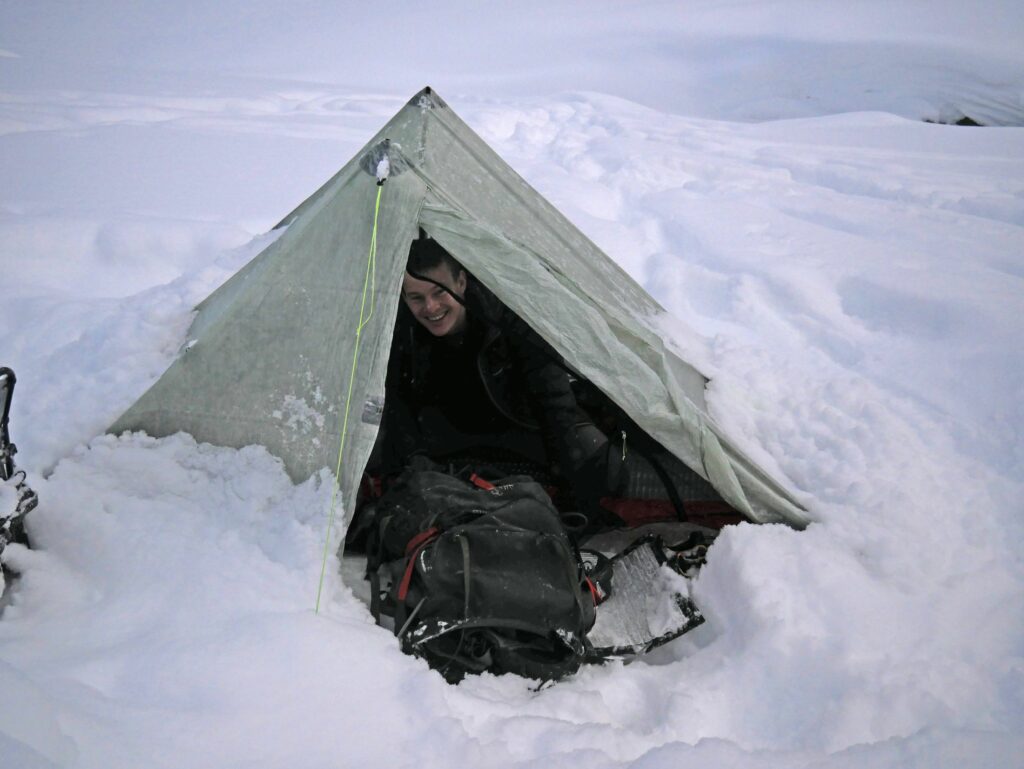
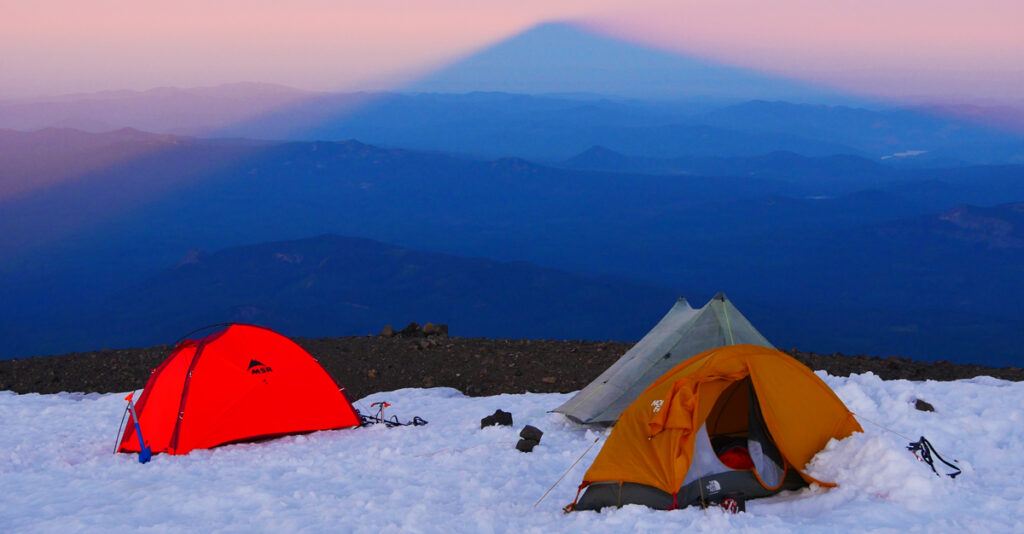
A note concerning Dyneema: I noticed this interesting Q&A on the Big Sky website:
Q: Any plans to do a version with Dyneema (DCF/Cuban fabric) outer/fly?
A: Big Sky has offered a number of 3-Season tents with DCF fabric since 2007 so we have quite a bit of experience with this fabric. The Chinook tent series is 4-Season rated so it requires a stronger fabric. If we offered a 4-Seasons tent with DCF it would have to be a stronger/heavier DCF fabric so it would not be much lighter weight than the current tent weight, but would be a LOT more expensive. Big Sky uses both sides silicone fabric that is twice as strong as the PU-coated fabric the big box tent companies use but is lighter weight and can be offered at a fair price. So no, it does not make sense at this time to offer a 4-Season tent with DCF fabric.
What About Hammocks?
Some hikers love hammocks, but you will likely find that a hammock is impractical in winter and at the higher elevations of the Cascade Mountains.
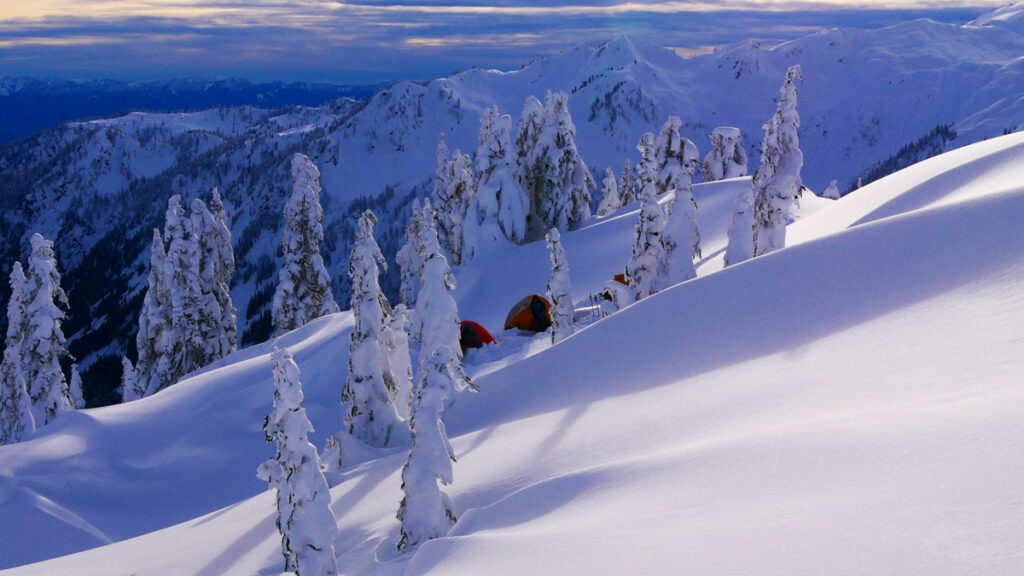
The trees are often covered in snow, dangerous to approach due to hidden tree wells, or too small or non-existent on the ridges and summits where we are usually camping. Hammocks can work at some locations and times of the year, but to get the best wind protection and to allow the greatest level of group freedom concerning camp selection, bring a tent too.
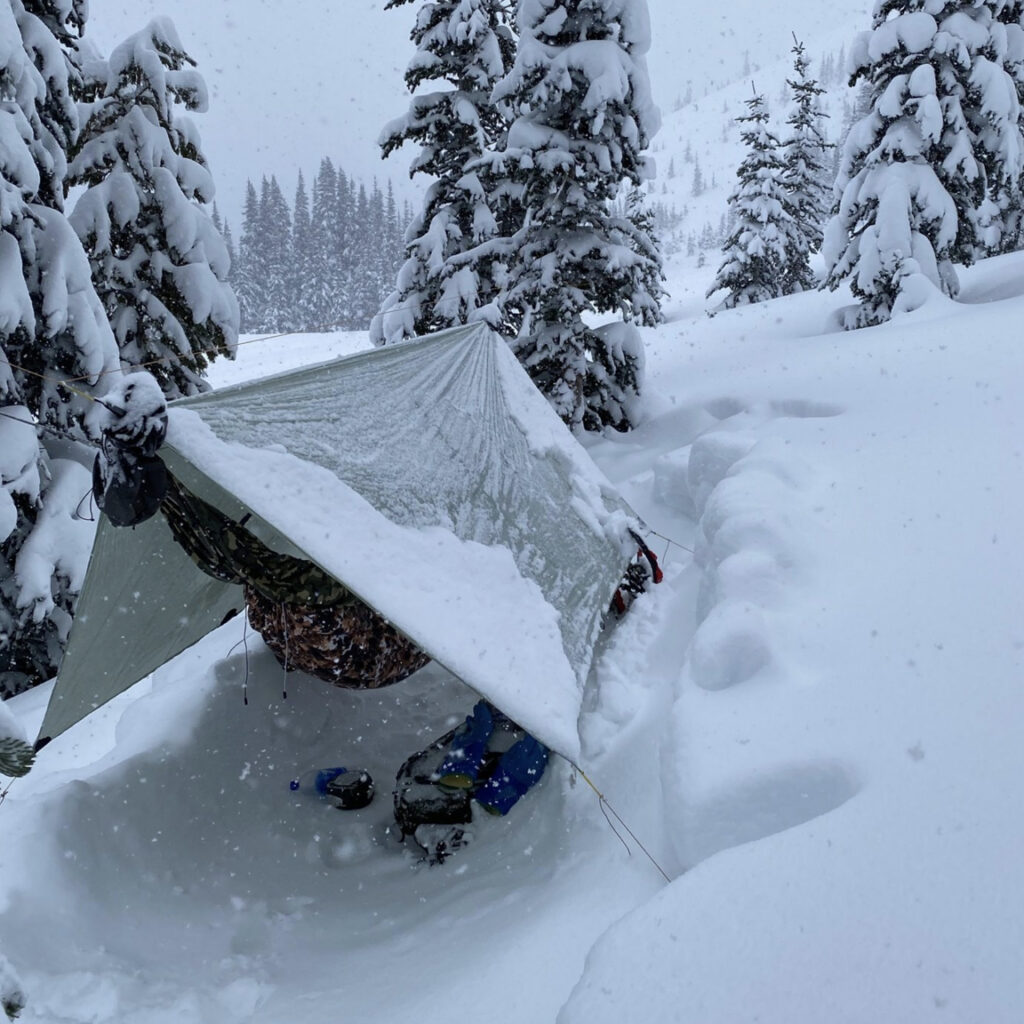
In many locations, it is also not possible to hang a bear bag from a tree. A bear canister allows better protection and more options when selecting a group campsite.
Three Winter Tent Tips to Know
- For camping on snow, you do not need a tent footprint, which reduces some weight and expense.
- You will likely need some snow stakes or pegs. The pegs with more surface area work best. Tiny aluminum pegs that come with summer tents are almost useless in soft snow. There are many different types of tent pegs designed for snow. The plastic Coghlan’s Yellow Tent Pegs are lighter than the brass REI Snow Stakes and work well in most situations.
- You will also need some utility cord for the tent corners because the stakes must be buried in the snow to hold the tent. The corner loops on the tent and the guy lines that come with the tent are usually too short for winter camping in deep snow. For more about staking out tents in the snow, see How to stake a tent in the snow without tying knots.
4-Season Tents
4-season tents are warmer and more durable than 3-season tents, and sometimes even lighter. These tents will add about 10ºF in warmth and keep out the snow and wind.
You may not be able to find a winter tent that is both breathable and fully waterproof. Sometimes compromises have to be made. Keep in mind that the main advantage of a 4-season tent is better wind protection. Don’t be so concerned about the tent adding warmth, rather be concerned about the tent’s ability to stop wind from robbing you of warmth even when you are in your sleeping bag.
What to look for in a 4-season tent for winter backpacking
Most 4-season tents are designed to withstand higher winds and shed snow. However, for winter backpacking in the Pacific Northwest, there are qualities that need special attention. That is, in addition to the ability to withstand moderate to high winds and shed snow, the ideal winter tent is double-walled and lightweight.
- A double wall: Double-wall designs are both breathable and waterproof. Small 4-season tents usually have a single wall. Single-wall designs are either waterproof and have problems with condensation or are breathable but not waterproof.
- Lightweight: Around 2–4 lbs. Many 4-season tents are designed to be used for extended stays at basecamps. Such tents are heavy (6–12 lbs or more) and usually taken to locations on pulks, pack animals, or even flown in. No one expects to move them often. For backpacking purposes, tents need to be lightweight and packable.
- Quick set up: Easy to set up in harsh conditions. This is especially characteristic of the simple X-frame design.
- Freestanding: Most winter tents are freestanding. This is helpful when you want to get out of the wind quickly when there is no wind and no pegs are required or when you want to pitch it on a frozen lake.
- Easy to vent or breathe sufficiently to reduce condensation.
- Packable: Small enough to easily fit in a backpack with all your other gear.
- Waterproof: Many 4-season tents are not waterproof because it is assumed that you will be in cold and possibly snowy conditions and not in the rain. Here in the Pacific Northwest, you may find yourself needing your tent in both snowy and wet weather.
Three additional features that are sometimes hard to find in small 4-season tents are (1) some front-door mosquito netting (usually not necessary in winter, but helpful in the shoulder season) and (2) tent vestibule (helpful in wind and rain, but adds weights).
Single-wall tents tend to have more problems with condensation. Even with a double-wall tent, when the tent is shaking in high wind the frosty condensation lands on your face. You can usually brush it off the walls and go back to sleep, but it is still annoying.
Even though a 4-season tent can add 10 degrees, you may not want the extra warmth it provides. If it is 25º F outside it will be 35º F inside your tent. This causes two problems:
- Instead of turning into frost, condensation will run down the inside walls of your tent and collect on your sleeping bag. To minimize condensation, I usually leave my tent door open as much as possible except when it is too windy or snowing. My sleeping bag provides more than enough warmth. That is, it is often best to just leave the door open and enjoy the fresh crisp winter air.
- If it is 25–30ºF outside, which is often the case here in the Cascade Mountains, the warmth inside your tent will melt the snow outside the tent. This is problematic if the tent is not waterproof.
4-Season Tent Examples
So what are your options? Here are some popular and current (2020) examples of 4-season solo or 2-person tents, listed from lightest to heaviest:
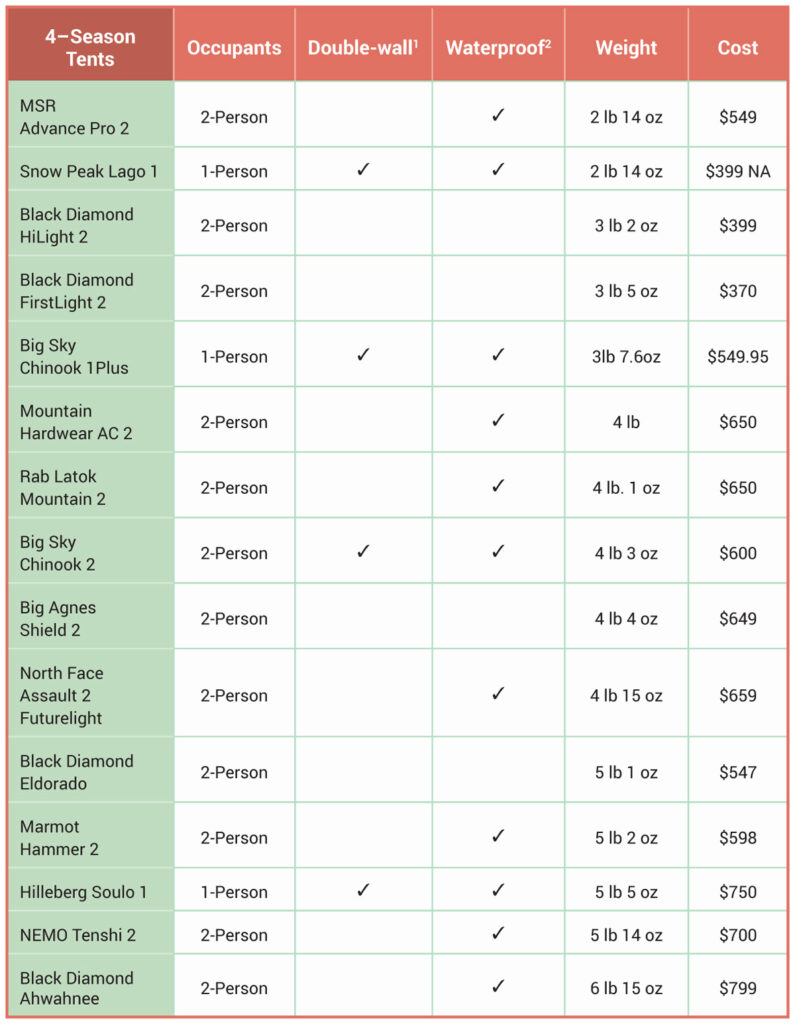
Here’s a list with links to the manufacturers:
- MSR Advance Pro 2 Ultralight 2-Person, waterproof, 2 lb 14 oz, $549
- Snow Peak Lago 1-Person, double-wall, 2 lb 14 oz ($399 but no longer available, maybe secondhand?)
- Black Diamond HiLight 2-Person, not waterproof, 3 lb 2 oz, $399
- Black Diamond FirstLight 2-Person, not waterproof, 3 lb 5 oz, $370
- Big Sky Chinook 1Plus tent, waterproof, double wall, 3lb 7.6oz, $549.95
- Mountain Hardwear AC 2, single wall but said to be waterproof, 4 lb, $650
- Rab Latok Mountain 2-Person, single wall but said to be waterproof, 4 lb 1 oz, $650
- Big Sky Chinook, 2-person, double-wall, 4 lb 3 oz, $599.95
- Big Agnes Shield 2-Person, not waterproof, 4 lb 4 oz, $649
- North Face Assault 2 Futurelight, single wall but said to be waterproof, 4 lb 15 oz, $659
- Black Diamond Eldorado 2-Person, not waterproof, 5 lb 1 oz, $547
- Marmot Hammer 2-Person, single wall but said to be waterproof, 5 lb 2 oz, $598
- Hilleberg Soulo 1-Person, double-wall, 5 lb 5 oz, $750
- NEMO Tenshi 2-Person, single wall but said to be waterproof, 5 lb 14 oz, $700
- Black Diamond Ahwahnee 2-Person, single wall but said to be waterproof, 6 lb 15 oz, $799
A light solo tent that works well for backpacking in winter conditions is hard to find.
Most 2-person tents are very tight for 2 people and a bit heavy (over 3lbs) for use as a solo option. This makes the 2-person MSR’s Advance Pro a good current choice for solo winter backpacking. The Big Sky Chinook 1 Plus is reasonably light and has the advantage of a double-wall design.
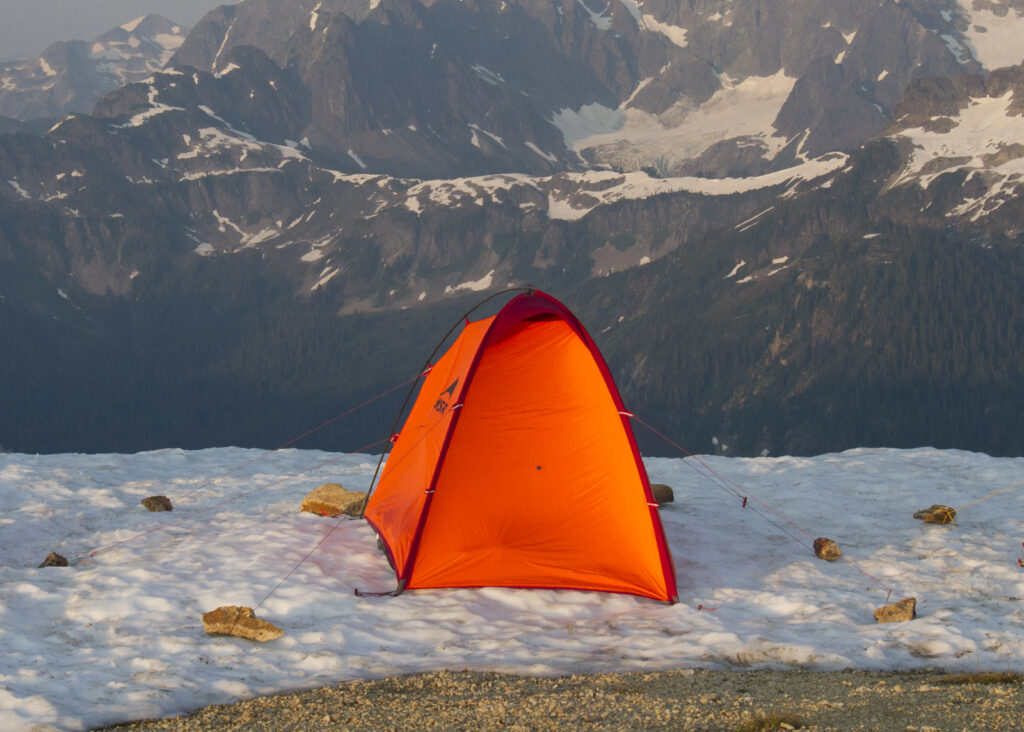
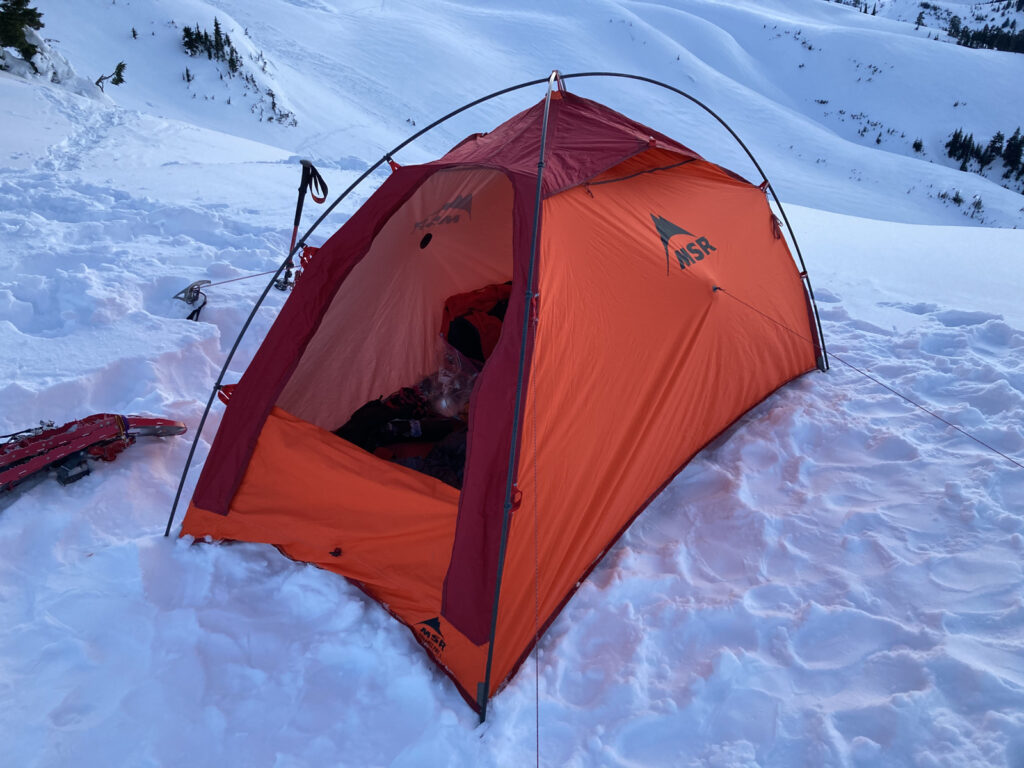
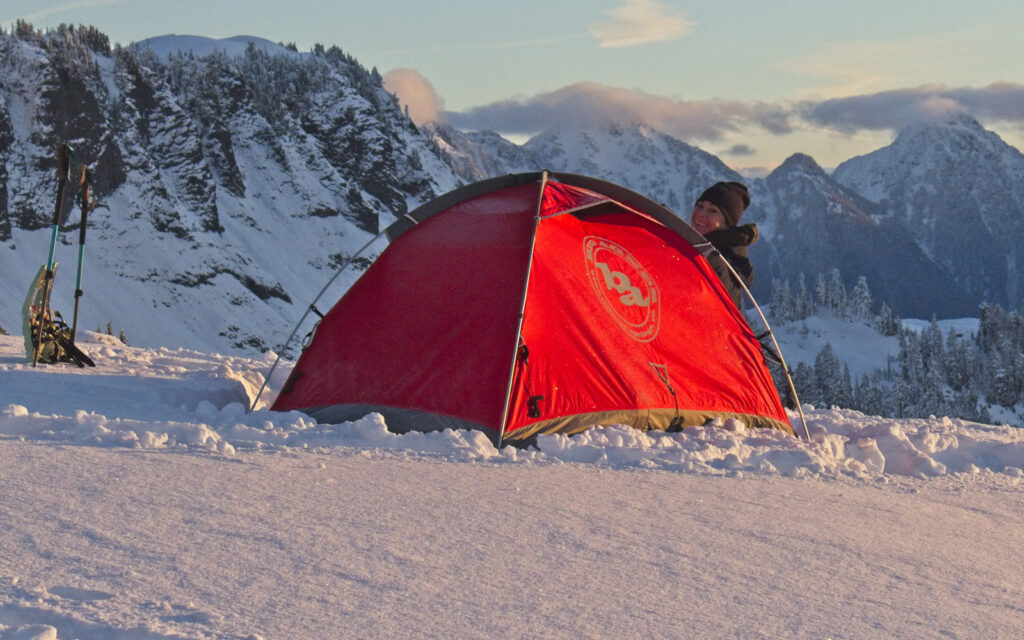
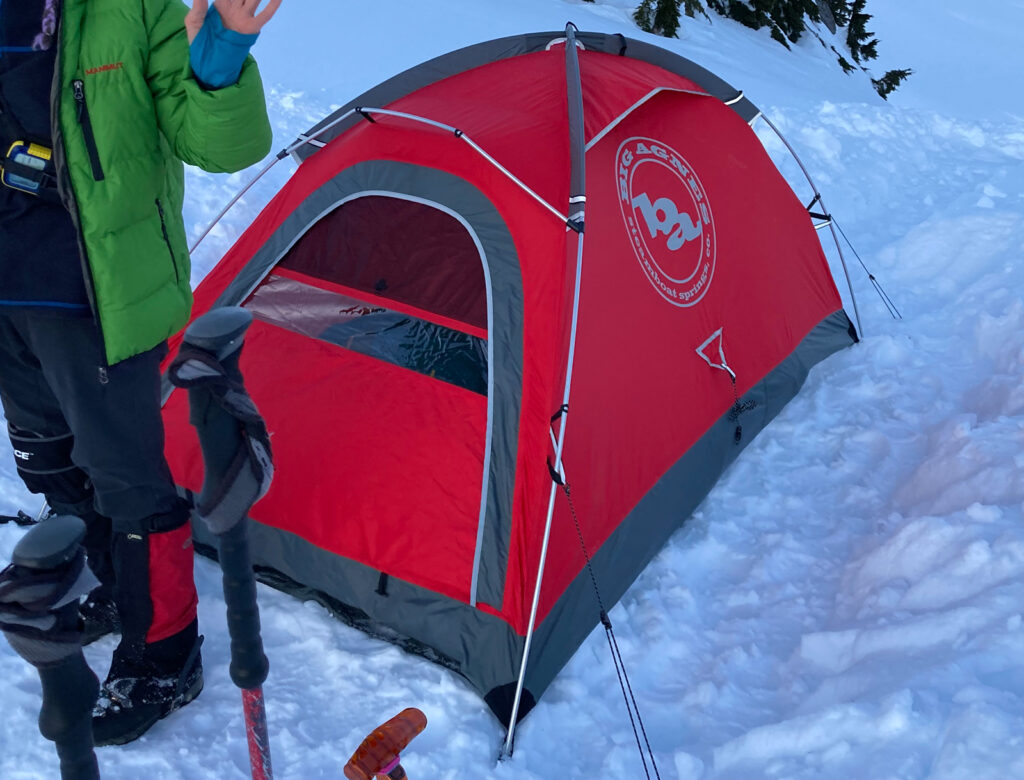
The MSR Access 2 (4 lbs 1 0z, $599) is also considered a 4-season tent, but it is not an x-frame design, so it is less secure at high elevations. However, it has a double-wall construction giving it more moisture protection than most alternatives. I have seen one functioning well in 20–30 mph winds.
While the MSR Access 2 may be a somewhat structurally weak winter option, some 4-season tents, such as the Hilleberg Soulo are stronger (expedition level) and consequently heavier than necessary for short winter backpacking trips in the Pacific Northwest.
The Tarptent Moment DW 1P (2 lbs 2 oz, $325.00 – $391.00) doesn’t look like a 4-season tent and doesn’t use an X-frame design, but it does claim to be 3–4 season capable. I haven’t seen any version in use, so I can’t comment on it, but it looks more on the level of a treeline tent, similar to the MSR Access 2. I also don’t know if their carbon poles have anything close to the durability of the MSR Easton “Syclone” poles, that flex in high winds.
What if you really do want a 2-person tent?
Some tents claim to be 2-person but are extremely tight. If you compare floor sizes, the Big Sky Chinook 2-person tent is roomy enough to be a true 2-person tent. Here’s a comparison of a few 4-season tent floor sizes:
- MSR Advance Pro 2: 82 x 42 inches
- Nemo Tenshi 2: 82 x 46 inches
- Big Sky Chinook: 91 x 47/53 inches
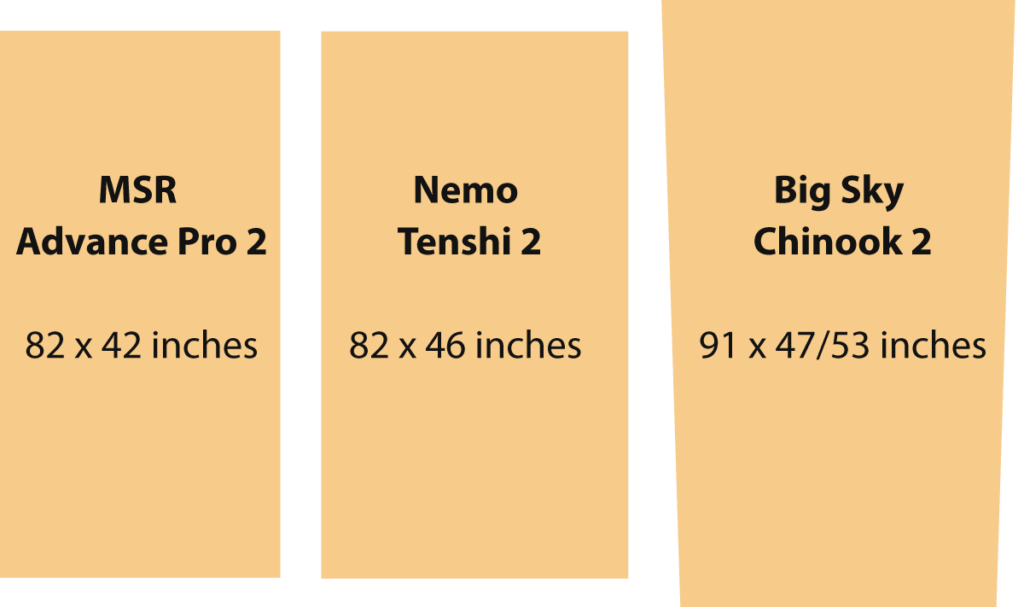
For 2 people, the Chinook’s 4 lb. 3 oz. weight is a good ratio. Best of all, this is a double-wall design, so you get breathability and better water protection.
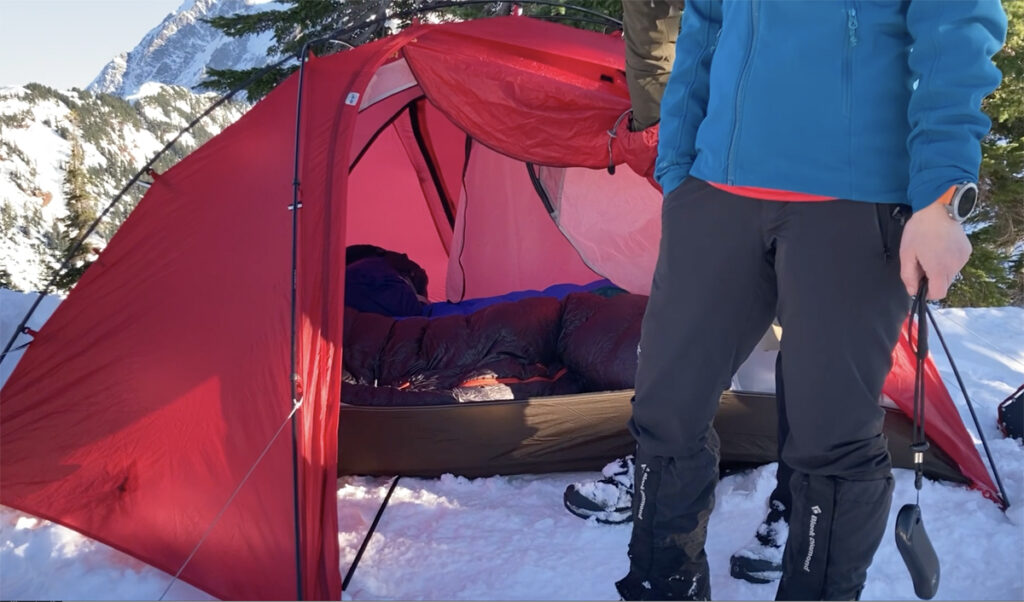
I have not yet seen the Big Sky Chinook in high winds, but the design seems sturdy.
The prices for 4-season tents are high but think of it this way, it is still cheaper than 1–2 nights in a resort hotel, and it is often possible to get them on sale or secondhand.
The tent I use
For nearly all my trips I use a 4-season tent—the Lago 1, an X-frame mountaineering tent designed by Yukio Yamai and no longer made by Snow Peak. It is nothing like the new model with a similar name. The company stopped making it when they shifted focus from mountaineering equipment to camping equipment. This is unfortunate because I have not seen a better solo 4-season tent made by anyone. There is a different Japanese company, AraiTent, that appears to be making a similar tent, the Air Raiz 1 (Air Rise 1), 1.36 kg or 2lbs 15 oz, (42,900 Y/$375. not including shipping).
One of the main advantages of the door on the end is that it makes it easy to sleep with your head under the stars. If snow falling on your face wakes you up, you can just close the door.
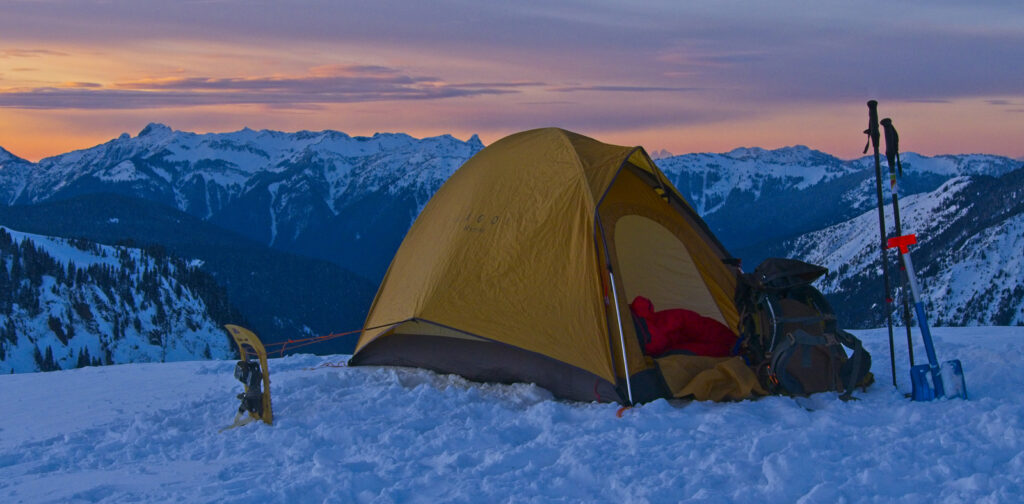
What about Expedition tents?
Expedition tents are great for extended trips in very harsh conditions. Here in the milder winters of the Pacific Northwest, they are unnecessary for short 2–4 day backpacking trips. If you want to carry a 7–10lb tent, you can, but there are plenty of reasons to avoid that.
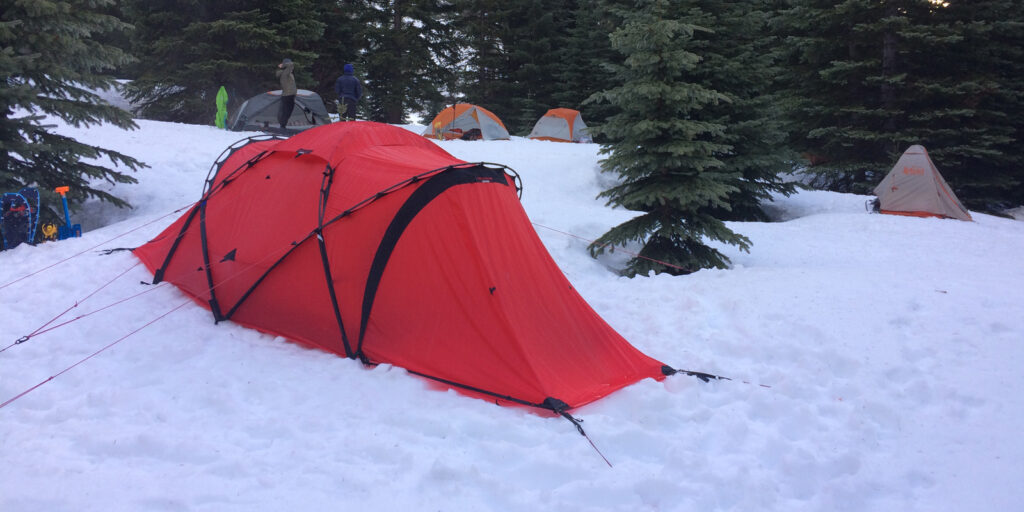
Winter backpacking didn’t really exist in the past because the required gear was too heavy to carry on long-distance treks. Winter travel was mostly done on skis on flat terrain with the gear strapped to a pulk or sled. Modern ultra-light gear is what makes long-distance mountain travel possible. The easiest way to lower weight is by reducing the weight of the big three—1) your pack (a pack with reduced size, frame, and features), 2) your tent (an ultra-light solo version), and 3) your sleeping bag (by upgrading to higher fill power, such as 800–950 down). Reducing these three items can often cut as much as 9 lbs off a person’s kit.
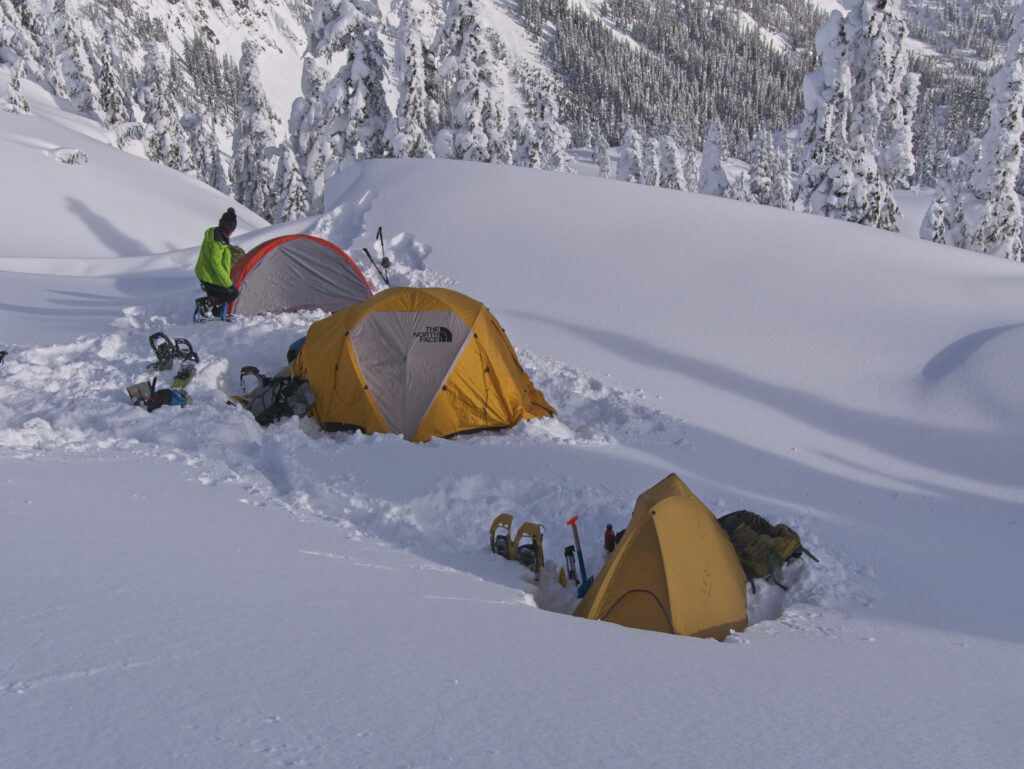
Disadvantages of 4-season tents
Why not get a 4-season tent and use it year-round? There are reasons issues 4-season tents don’t work well as all-purpose backpacking tents:
- Too much condensation. This is especially true of waterproof single-wall tents.
- Too hot. They can be too hot for summer use (less ventilation).
- Not designed for rain. Some models are not fully waterproof and perform worse in rain because of leaks through the air vents. Most 4-season tents are designed for winter, meaning for snow rather than rain.
- Weight. Some models are heavier.
- More confining. They are more enclosed, allowing less of a view. Removing the fly or outer wall—if there is one—doesn’t open up views because the walls are solid rather than just mosquito netting.
The cost could be added to this list, but if you want to backpack year-round, you’ll likely want both a 3-season and a 4-season tent.
In some ways, a 4-season tent is really a 1-season tent (winter) or a tent for three different seasons (fall, winter, spring).
Tent Makers
REI and MSR (once owned by REI and now owned by Cascade Designs) are based in the Seattle area next to the Cascade Mountains. These companies are well situated to create gear suited for backpackers and climbers in the Cascade Range. Big Sky International is based in Jackson Wyoming. Black Diamond Equipment originated in California and relocated to Utah near the Wasatch mountain range. Their global headquarters is located in Innsbruck, Austria. Big Agnes, Marmot, and now The North Face (originally California) are based in Colorado. NEMO Equipment is based in Dover, New Hampshire. Rab is a British manufacturer based in Somercotes, England (the wet cold weather of Britain is similar to the Pacific Northwest). Hilleberg is a Swedish company that now has an American division in Seattle. All these companies create some great gear for recreational use around the world, but you will likely not find one company that meets all your gear needs perfectly.
Should You Upgrade to a 4-Season Tent?
If you already have a 3-season tent that works for winter, should you upgrade to a 4-season tent? Here are some things to consider:
1. More new tents are coming
A 4-season tent offers noticeable advantages, especially an ultra-light freestanding one that is capable of withstanding high winds. However, now may not be the best time to upgrade. There is a rush among gear manufacturers to produce lighter and better tents. Two-person and especially solo winter tents were rare, but new models have appeared recently and there have been upgrades to these models.
Even mountaineering tents made with Dyneema will probably become available soon, although they will likely be expensive and condensation will be a hurdle for Dyneema. The French company Samaya is making a single-wall X-frame Dyneema design with carbon poles—the 2021 Assualt2 Ultra (1600€, $.1966!). Perhaps we will see double-wall tents with Dyneema outer walls. I also expect more tents to adopt lighter flexible poles similar to the Easton “Syclone” poles used by MSR.
2. Is your winter kit complete?
Any 4-season tent is going to be an investment. That being the case, it is worth considering your priorities. Is your winter backpacking kit complete? That is, rather than upgrading specific items, first, be sure you have everything you need for the safest winter backcountry recreation. In particular, if you’re already on a limited budget and have a workable 3-season tent, be sure you first have avalanche gear—transceiver, probe, and shovel. And, of these three items, realize that the transceiver is the most important. Without it, the chances of anyone finding you quick enough in an avalanche is greatly reduced. With all three items not only will you increase your own chance of survival in an emergency, but you may be able to help save the life of someone else as well.
Likewise, if you only have a 15ºF sleeping bag, maybe a 0ºF sleeping bag is a bigger priority over a 4-season tent.
3. Will it be your first tent or an additional tent?
If you already have a 3-season tent, getting a single-wall tent 4-season tent that is not fully waterproof may work fine. You can always take the 3-season tent instead if you think water is going to be the bigger concern. If a new 4-season tent will be your first or only tent, you may want it to be as versatile as possible. In this case, consider a double-walled tent that will work in both rain and winter conditions.
***
Obviously, this is a very brief presentation on backpacking tents, but the 3-season tent question comes up so often I wanted to quickly sketch out some key points and include actual examples of tents I have seen in use. I will revisit this topic and add more details in the future.
Thanks for reading this blog. Let me know your thoughts and comments. Please comment below.
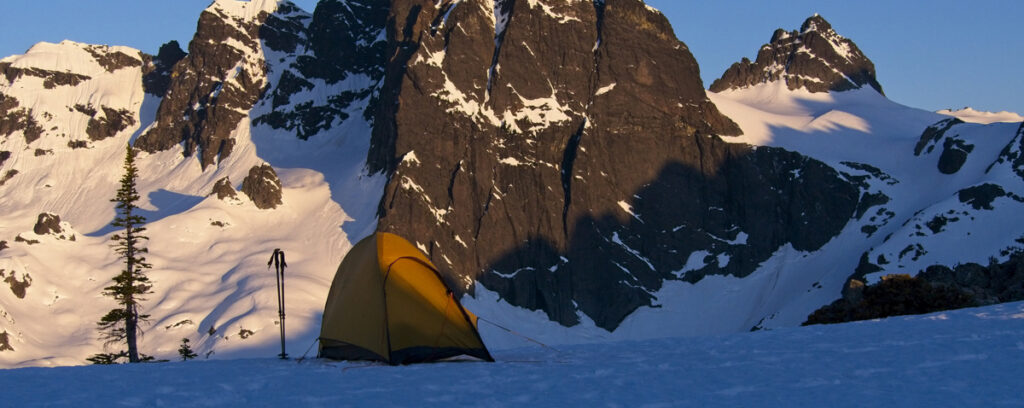
17 replies on “3-Season vs. 4-Season Tents”
Thanks for the great article and excellent resources on winter/snow camping! Newbie backpacker here. What are your thoughts on using a nonfreestanding 3-season tent for camping on snow in the spring/summer at higher elevations in the PNW? I have a Eureka Spitfire, and from reading your other article on staking tents on snow, sounds like I might be able to use my existing tent and just get some snow stakes + cords for deadmans. The only problem I could think of is wind… Wondering if there’s any other drawbacks with using a nonfreestanding tent?
The Eureka Spitfire should be fine. For somewhat windy conditions longer cords and deadman stakes should provide enough security. In the spring/summer months the snow is consolidated and you may not have to bury the stakes. I pitched my tent last week in 15–20mph winds just using 4 stakes (2 on the corners facing the wind and one on each side for the fly). The snow was hard enough I didn’t use the deadman method. The temps were around 36–40ºF and by morning the snow was rock hard. Any tent, if not anchored well enough, will blow away. What makes the free-standing tent better is not that just that it is free-standing and easier to set up, but that the x-pole design is stronger. If there are high winds a Eureka Spitfire may not hold up well. Look for some kind of rock formation or trees to provide a windbreak. It will be a much quieter that way and you’ll get better sleep. But main point—the Eureka Spitfire should be fine.
Thanks for the reply! I’ll do more research on tents with x-pole design, but good to know that I can use my existing tent for the meantime until I’m ready to invest in a new one. Then perhaps I can start to do some winter backpacking too – would love to join one of your trips in the future!
Hi JK
Glad to help. If you would like to join us on one of our trips, you can sign up here: https://www.meetup.com/Winter-Backpacking-in-the-PNW/
Hey, Im thinking of buying the North Face Storm Break 1 for Fall Mountain trips. How tight is it? I’m 6’2, 180lbs, will I fit with fall gear in the vestibule? Thanks
Hi Rob. It would be great if you could find someone who could let you try it out before you buy one. I think you’ll fit, but it will be tight. I’m 5’7, 150lbs. My complaint is this: When I get to camp, I want to get out of the weather and put on a fresh base-layer. Sitting up and pulling off a shirt in this tent is a challenge. The main tent mosquito netting attaches to the poles with clips, rather than sleeves, and this means the actual tent is much shorter than the height of the poles and the X-frame design makes it narrow at the top. No head or shoulder clearance when trying to sit up. So compared to some similar X-frame tents, it is small. My Snow Peak 4-season tent is an excellent X-frame design that holds up well in high winds, but because it is no longer made, I can’t replace it if wind destroys it. For that reason, I took a NF Stormbreak to camp on Mount Adams, expecting high winds (we camped at 11,000ft near the final summit). It was fine for a one-night trip even with all my gear inside and snow shoveled around the sides. I will mainly use it in shoulder season camping when high winds are expected. For most shoulder season trips in moderate weather, I’ll use a Big Agnes Copper Spur UL1.
I recently happened on your informative site. Lots of good information here. Longtime backpacker, but relatively new to winter outings, so i’m still tweaking my winter kit.
My first winter tent purchase was the Tarptent Scarp1. Nice tent, sturdy in wind, sheds snow pretty well, but it’s not freestanding, so set up on snow can be fussy and time consuming since stakes take some time to sinter/set in the snow.
Considering switching out to a 3.5-pound BIg Sky International Chinook 1Plus or, for another $50 and 8 more ounces, the Chinook 2, which is considerably wider. Haven’t seen one in person, but the reviews i’ve seen are positive. I’m just over 6 feet, and one nice feature in a 91-inch interior length. Double walled, so helpful with condensation.
Hey Nick – Thanks for sharing this. I haven’t seen a Big Sky tent here in the PNW, but I looked it up and reasonable weight, nice X-Frame design. Looks good!
Back for an update: So, i finally decided to pull the trigger on the Big Sky Chinook last fall. After ordering, they informed me there would be a few week delay. No problem. Well, delay built on delay, and, long story short, more than three months later, i still had no tent, and they had stopped updating me on delivery status. And they had charged my credit card, so they had my money for almost four months. I eventually was refunded, but, even allowing for pandemic-related issues, the way they handled this was unacceptable.
So, i was back to surveying the winter-tent landscape. For various reasons, none of the most-often recommended/usual suspects appealed to me. Just took a look at some of the models from AraiTent that you mentioned (that i had never heard of), and they look interesting. I think there’s some kind of Murphy’s Law out there that says no matter how much you research something, there will always be something you overlook and will discover only after you decide to make a purchase.
What i ended up plunking money down on last month was a SlingFin Portal, with a “Packaged Weight” of 3 lbs. 5 ozs. and claimed four-season capability. Well-reviewed from what i could find. It was on sale on pre-order, and is expected to ship later this month. Here’s hoping!
Sorry you had that experience. There is an ongoing supply-chain problem that many businesses are still experiences, but they should have refunded you much sooner.
If your current choice doesn’t work out, there is another tent that also looks interesting — the LiteFighter 3-season tent (about $335) which has a clever way of converting to a 4-season tent (https://litefighter.com/product/litefighter-1-individual-shelter-system/). The winter conversion kit is an extra $120 (https://litefighter.com/product/litefighter-1-cold-weather-kit/) The 4-season set up weighs around 3.6 lbs, which is pretty good. I expect to see more companies copy this concept in the future. I hope to do a review in the future.
I get so much spam from bots and what not that I may by mistake occasionally delete a few legit ones when clearing my mailbox. If your comment doesn’t get approved it most likely got deleted by error, so please repost. I want to hear from as many hiker as I can.
It seems that while it’s considered a 3 season tent, the Durston XMid 2 and Durston XMid 2 Pro are getting a fair amount of attention for tree line winter camping. Of course they are either unavailable or backlogged.
The XMid 2 Pro is a single wall DCF. Since it uses 0.55 ounce per square yard DCF it may not be sturdy enough in harsh conditions. Only weighs 20 ounces.
The weight is great. I would like to see something like this that is free-standing, so I can get in it quickly in cold wind and just anchor it with my body while I change into camp clothes and also, to make it easier to set up on frozen water. The other problem is the high costs and lower durability of these materials. I suppose that may change.
What are your thoughts on the newly released ArcDome tent by TarpTent?
https://www.tarptent.com/product/arc-dome
Overall, it looks easy to use and has some useful features. My main concern would be, if I understand correctly, it weighs in at 3 Lbs 9 oz which is a little heavy for a tent with no floor sealed to the walls. If I can get a double wall, X-frame design, 4-season tent that is 3 lbs (like the Leipen) that can fully seal out cold windy weather, I would go with that.
Hi, Interesting tents! I have never seen these Japanese models before! I do mostly multi-week Nordic ski-touring in northern Norway, Sweden, and Finland, plus here in the Alps (I live in the Dolomite’s foothills). I previously lived in Leavenworth WA (plywood Bavaria) and Estes Park CO, I know both the northern Rockies and Cascades ranges well. The comment suggesting that the Norwegian mountain area are “gradual” is not really accurate. You can find challenging mountain terrain the entire length of the country except perhaps in Finnmark. You are almost always above tree line there. Looking at your photo gallery- I don’t really see any terrain in those pics that one could not pull a pulk on, pulks are not just for flat, rolling, or gradual terrain. A lot of that terrain resembles Norwegian terrain that we frequently encounter. We can descend steep slopes on skis with pulks and turn and control our descents, I imagine this would be no problem with snowshoes as well I was curious about the diameter of the poles in the tents you tested(?). If you like solo tents you should check-out the Nordisk Svalbard 1SI- it is lightweight, but it can withstand winds up to 32.7 meters/second (73mph). It is retails for 250-350 EUR. It is an absolute bomber tent and reasonably priced. They make a polyester version that costs less too.
Hi Mick. Most of our trips can be done with a 28–32 lb pack so there is no real need or motivation to use a pulk. The terrain in the photos may be misleading. Most of our routes have forest sections and slopes with trees and rock fields that would be difficult for a pulk. We have been discussing using pulks for multi-day trips in the Steens Mountain area and other more open routes. Unfortunately your comment nearly got lost in the spam folder. Sorry for not spotting it sooner. We would enjoy seeing your winter trip photos on our Facebook Group page (https://www.facebook.com/groups/2796322520594839)